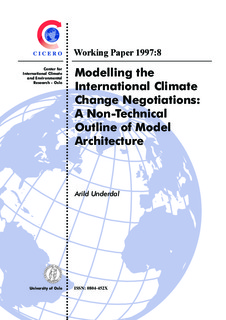| dc.contributor.author | Underdal, Arild | nb_NO |
| dc.date.accessioned | 2014-03-17T14:31:03Z | |
| dc.date.available | 2014-03-17T14:31:03Z | |
| dc.date.issued | 1997 | nb_NO |
| dc.identifier.issn | 0504-452X | nb_NO |
| dc.identifier.uri | http://hdl.handle.net/11250/192156 | |
| dc.description.abstract | One of CICERO’s current projects – undertaken in collaboration with the Fridtjof Nansen Institute – aims at developing a model enabling us (1) to explore systematically the political feasibility of alternative policy options, and (2) to determine the settlement range – i.e. the set of politically feasible solutions – in the global climate change negotiations. This paper provides a non-technical outline of the overall architecture of the model, and describes briefly its main components or modules. More specifically, it addresses three main questions: (1) In what terms should we characterise policy options? (2) How can we best describe the negotiation system, including the institutional setting, the configuration of actor preferences, and the distribution of relevant political resources ("power")? (3) How can political feasibility be determined on the basis of data about policy options and the negotiation system? | nb_NO |
| dc.language.iso | eng | nb_NO |
| dc.publisher | CICERO Center for International Climate and Environmental Research - Oslo | nb_NO |
| dc.relation.ispartof | CICERO Working Paper | nb_NO |
| dc.relation.ispartofseries | CICERO Working Paper;1997:08 | nb_NO |
| dc.title | Modelling the international climate change negotiations: A non-technical outline of model architecture | nb_NO |
| dc.type | Working paper | nb_NO |
| dc.source.pagenumber | | nb_NO |
| dc.identifier.cristin | 336023 | |
